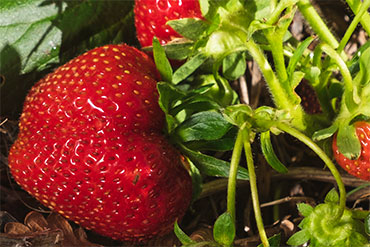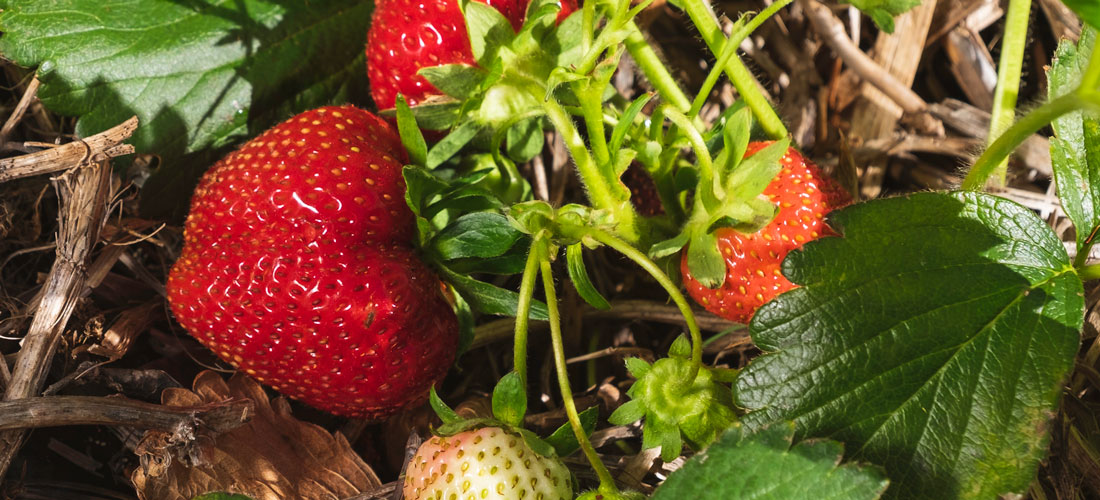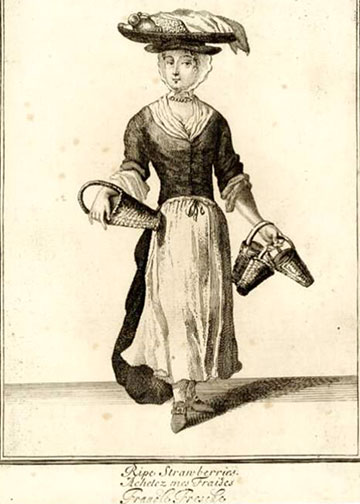
A Miscellany of Strawberries
- Myths, Folklore & Trvia
For centuries, the strawberry has been interwoven with our lives. In our cuisine, folklore, art, and herbal medicine. However, acceptance didn’t come easily despite the tiny fraise de bois or woodland strawberries intoxicating flavour and perfume. During the Medieval period there were those who thought they were unfit to eat as they grew where toads and snakes could creep over them. That pregnant women should avoid eating or touching them as their babies would be born with strawberry shaped pink birth marks. But the strawberry was never ordained to remain a neglected and lambasted forest food forever. Before long they captured the palettes of the rich, hearts of the romantics, imagination of artisans and the intrigue of the apothecaries
Found all over Europe they were small. No larger than a small fingernail, they tenderly hugged the ground while growing, while the fruit and runner plants spread madly in all directions. Perhaps, its contemporary name is derived from the Anglo-Saxon name streawbergie or variant streabariye. Where streaw means spread, scatter or stray.

The Ancient Romans were the first to cultivate them, calling them Fraga meaning ‘fragrant things.’ It’s likely they were eaten in small quantities and used predominately to alleviate a vast array of symptoms from melancholy, fainting, inflammation, and fevers to diseases of the blood, liver, and spleen. What a splendiferous panacea for the ailing! Little’s known of its use until they were cultivated in France in the late 1300s. With no domestication of the plant at this time, they were merely transplanted from the woodlands. The scene was set when King Charles V created a strawberry-coloured sea of over a thousand plants in his Parisian Garden at The Louvre. A few years later, the Duke and Duchess of Burgundy planted a large area in their Dijon Estate spurring others to cultivate their own luxurious berries.
Sold in cone shaped straw baskets called 'pottles'
On the other side of the channel, English ladies indulged their love of strawberries and cream by having plants cultivated in their gardens. The strawberry affair became contagious. By the 1600s, they were sold by wandering street vendors in London and Paris. Picked at their peak, these fragile fruits demanded protection and were packaged in unique cone shaped straw baskets called ‘pottles.’ Harvested, packed, and rushed to the market, they were expensive and soon gained a reputation as an upper-class snobbish food.
The frais de bois is a reminder of nature's creative wisdom.
Today’s cultivated strawberries, a combination of two different species, may be bigger but do not match flavour and perfume of their woodland counterpart. The frais de bois, still available, is a reminder of nature’s creative wisdom. Bright red, perfumed, succulent and easily detached from its mother plant, how could birds resist temptation. In devouring the strawberry, it spread hundreds of seeds and the procreation of the species was assured.
This humble joyful plant, in conquering our hearts and minds has left a legacy that’s centuries old. These are just a spattering of the lesser-known facts and folklore of the legendary strawberry;
But it's not a berry at all
- It’s called a berry, but it’s not a berry at all. It has a unique form. The seeds are on the outside! Often, it’s described as a false or secondary fruit or a ‘seed organ.’
- The average strawberry has 200 seeds. Obviously not an appropriate food choice for diverticulitis sufferers.
- They don’t continue to ripen after harvest, so they should be picked at peak ripeness. Containing pockets of air, which weakens the fruit structure, they go soft and mush easily.
- The strawberry was a symbol for Venus, the Goddess of Love, because of its heart shape and red colour. Contrary to this, Queen Anne Boleyn, the second wife of Henry VIII had a strawberry shaped birthmark on her neck: some claimed this proved she was a witch.
- Other myths have it that if you break a double strawberry in half and share it with a member of the other sex, you will fall in love with each other. Or if a young man dreamed of strawberries his wife would be sweet-tempered and bear him many children-all boys.
- In Northern Europe, during the Middles Ages, newly-weds were served a soup made of ripe, freshly picked strawberries, soured cream, and borage as part of their traditional wedding breakfast.

- Pottles held less than 4 cups (quart) and sold for sixpence. The crier added a penny to the sell price for the pottle and refunded it if the customer return. Early recycling in action.
- Pottle description from The Universal Gardener and Botanist (1778) Pottle baſkets are the moſt convenient for ſending quantities of ſtrawberries, raſpberries, and mulberries, choicer ſorts of early cherries, and the moſt delicate ſorts of ſmall plums, to market, or to any diſtance; theſe are very ſmall, upright, chip Baſkets, holding about a quart, being ten or twelve inches deep, very narrow at bottom, and not more than four or five inches wide at top, where there is a croſs handle. The London gardeners uſe vaſt quantities of them, buy them at ninepence or a ſhilling per dozen, which when filled with fruit, they pack many together in a large Boat-baſket, ſo ſend them to market on men’s heads, or otherwiſe.
Untitled: Courtesy The British Museum © The Trustees of the British Museum.
- The strawberry represented righteousness and perfection. Elegant design were carved into alters, on the tops of colonnades and in church pillars to symbolise these revered traits. Artists often depicted the Virgin Mary with strawberries to symbolise perfection and righteousness.
- Madame Tallien, a prominent figure of the Napoleon’s court was famous for bathing in the juice of fresh strawberries. She used 22 pounds per basin. It’s said that ripe strawberries were eaten to relive hot flashes and redness of the face. One wonders if this was a prescribed remedy or just another case of Napoleonic eccentricity.
- The American Indians were eating strawberries before the Colonists arrived. Crushed and mixed with cornmeal they made a baked strawberry bread. After trying this Colonists developed their own version and Strawberry Shortcake was created. So they say.
- In parts of Bavaria, some country folk still practice the annual spring rite of offering strawberries to the woodland elves. Small baskets, brimming with wild berries are tied to the horns of their cattle. It’s their belief the elves, who are passionately fond of strawberries, will help to produce healthy calves and abundance of milk in return.
The best of two worlds
- Early cultivation began with the French when they transplanted the woodland strawberry (Fragaria vesca) directly into their gardens. But this has no connection with our current species. The Virginian strawberry (Fragaria virginia) from North America and the Chilean strawberry (Fragaria chiloensis) from Chile both travelled from the New World to France through different circumstances and time periods. In the 1700s they were cross bred ,to combine the best features of both plants. Successive breeding produced the current variety (Fragaria x ananassa) we enjoy today.
‘Strawberry fields is wherever you want to go’
John Lennon
